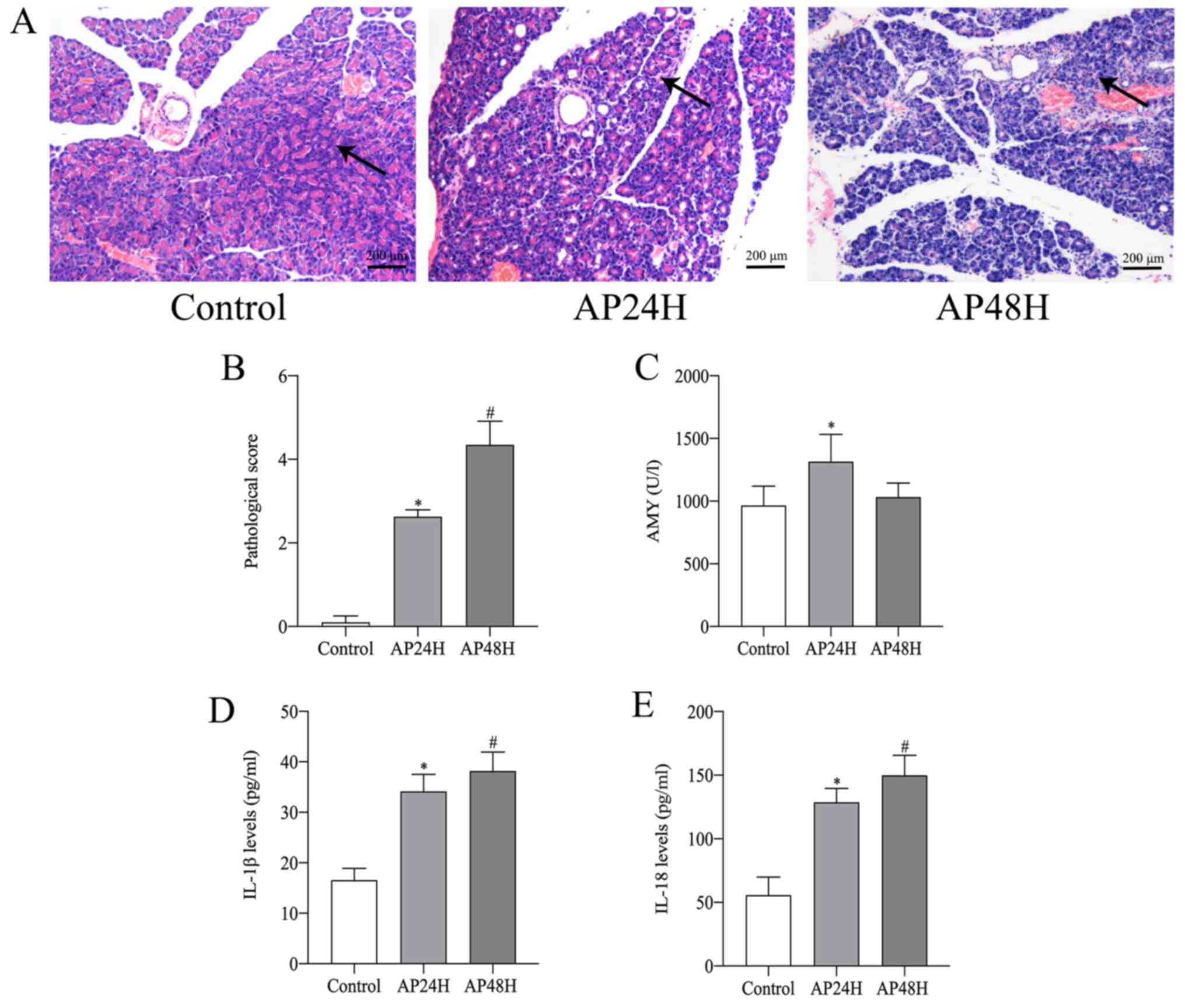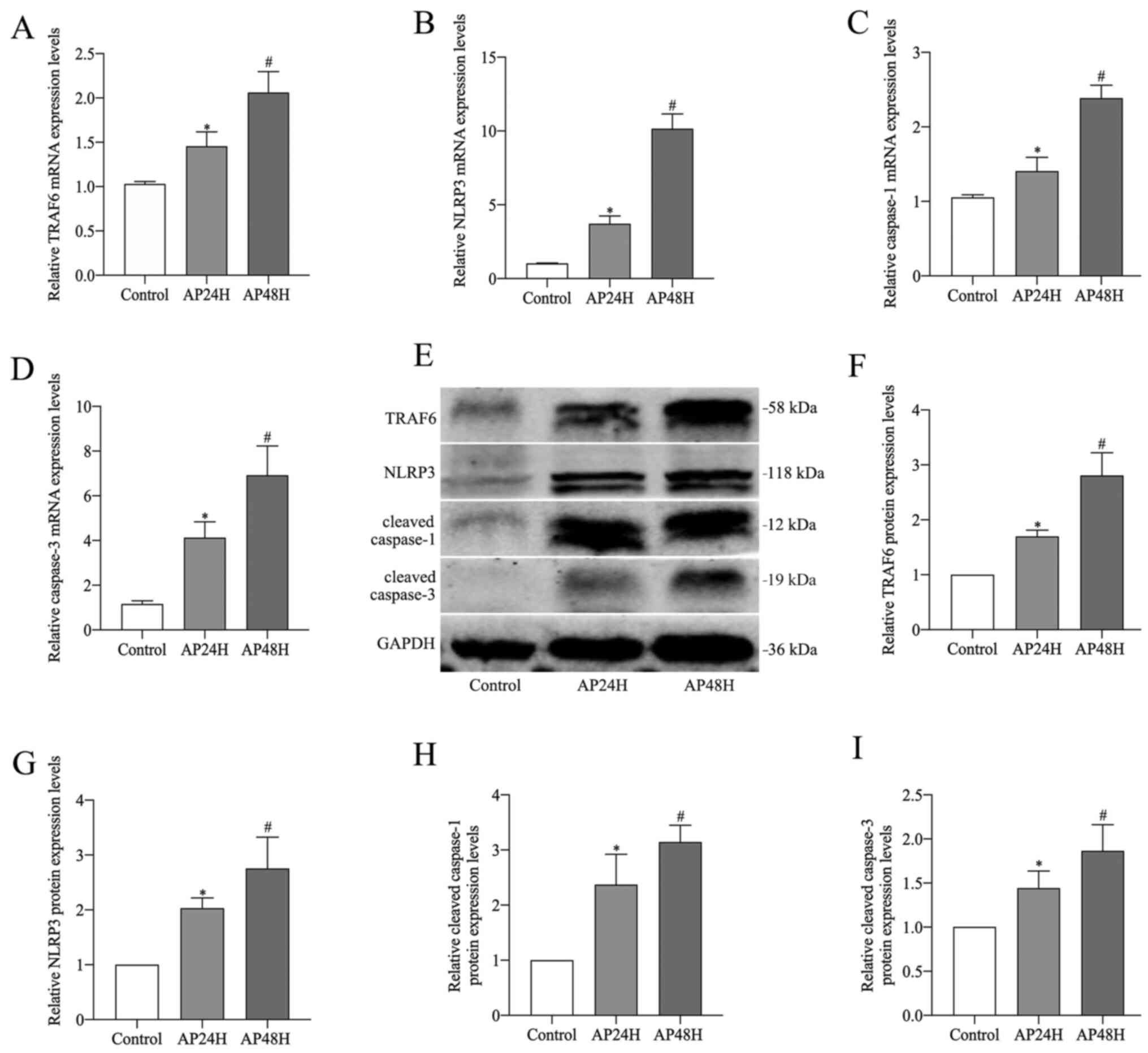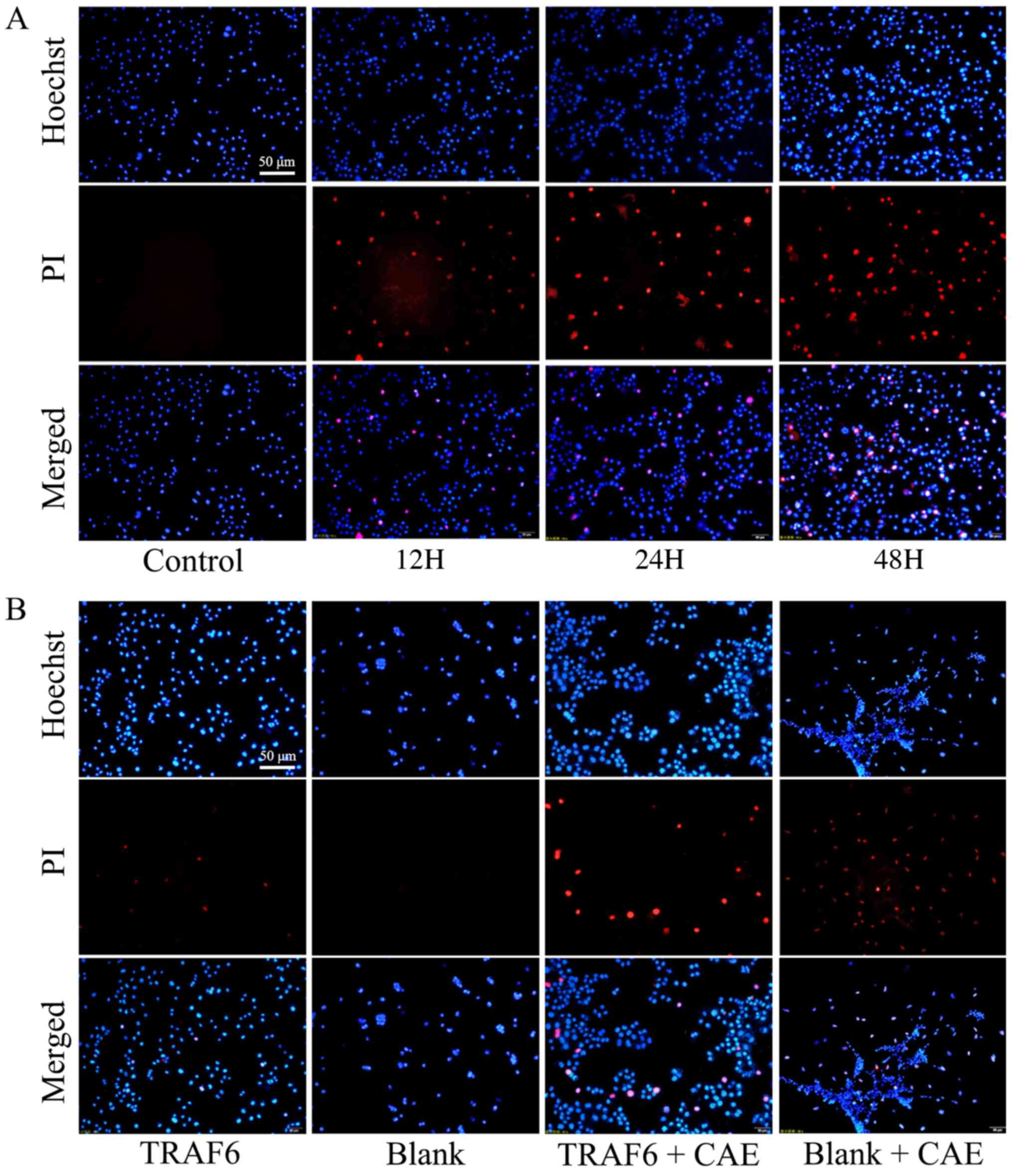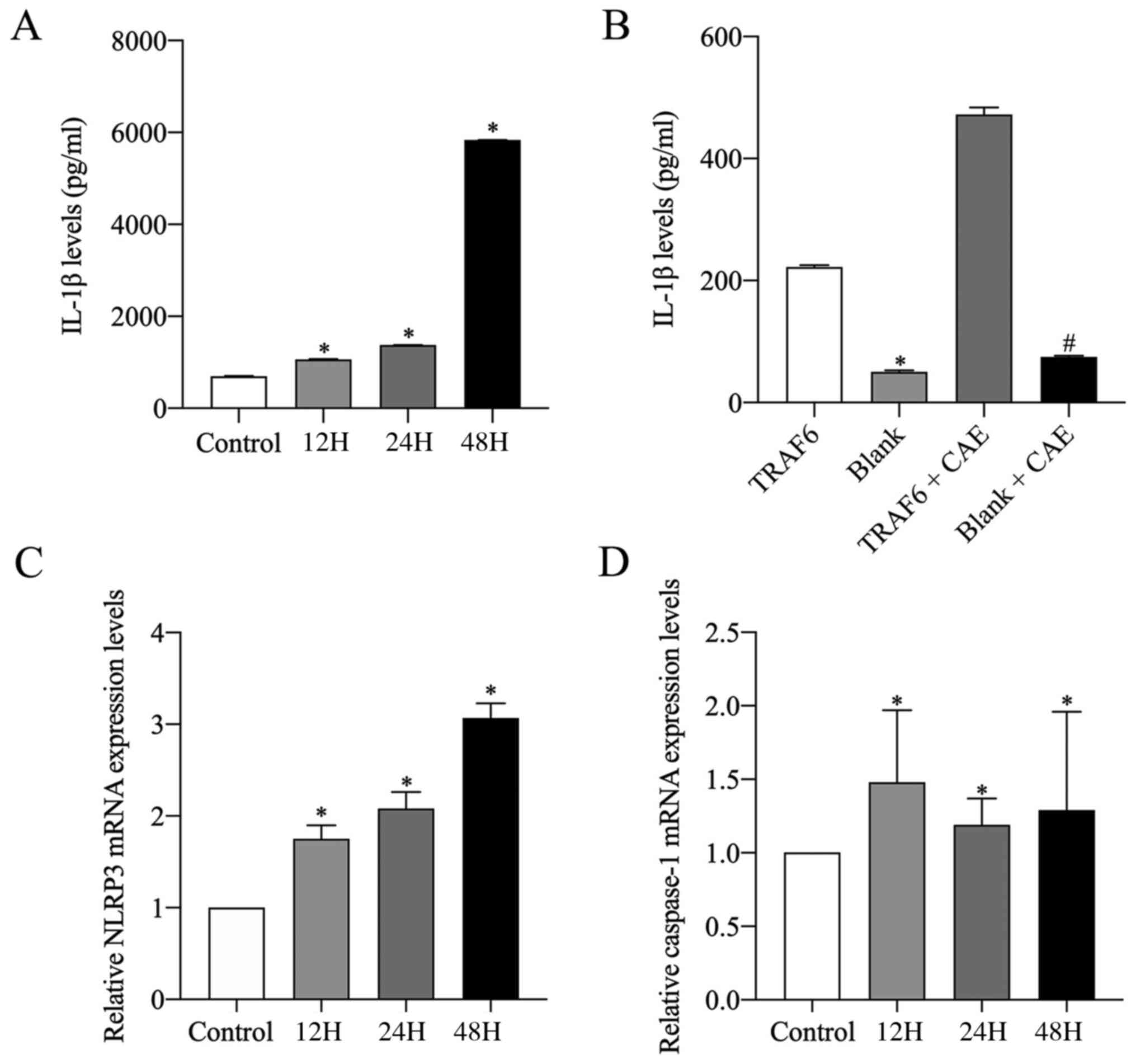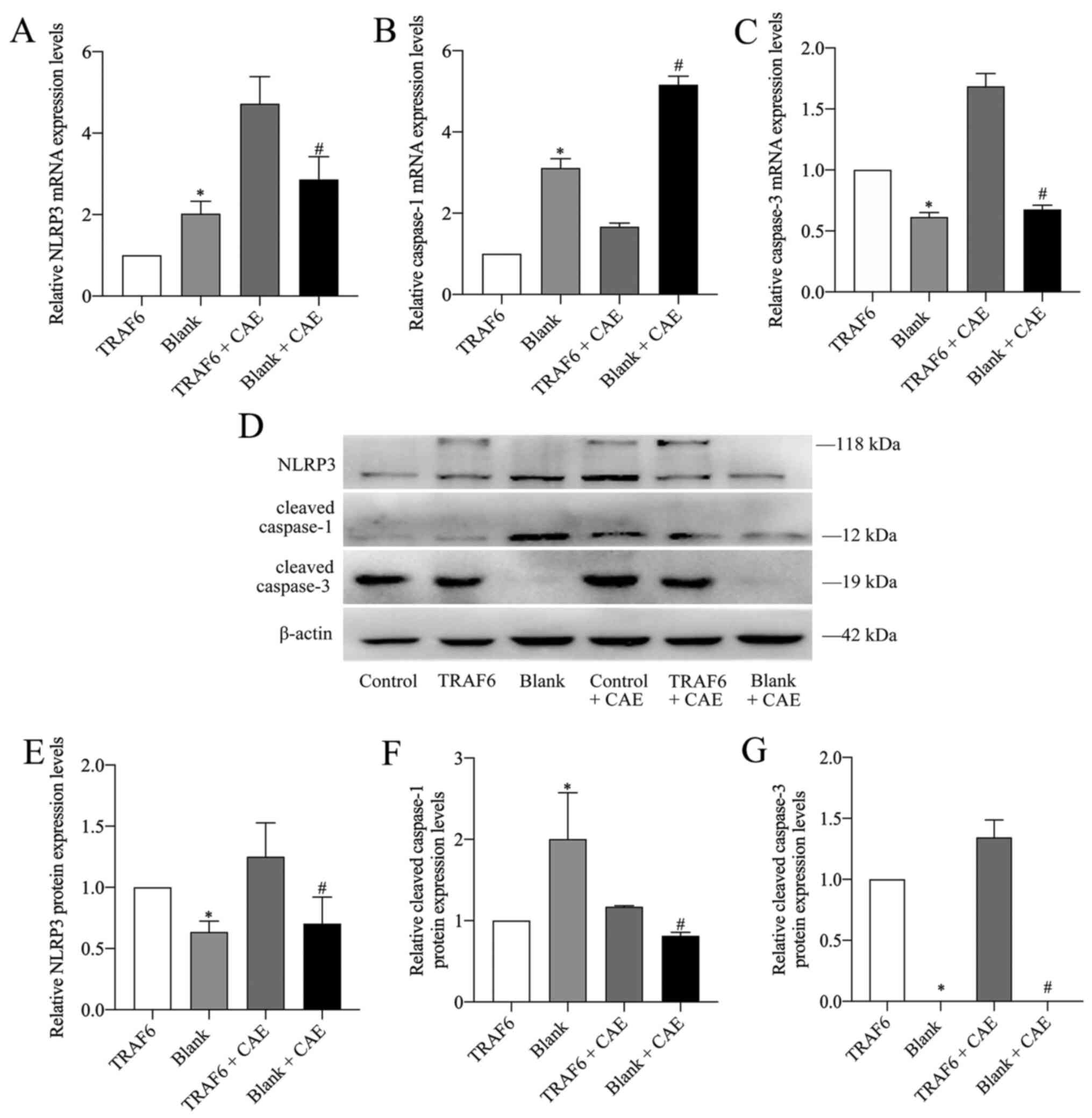|
1
|
Shah AP, Mourad MM and Bramhall SR: Acute
pancreatitis: Current perspectives on diagnosis and management. J
Inflamm Res. 11:77–85. 2018. View Article : Google Scholar
|
|
2
|
Sendler M, Mayerle J and Lerch MM:
Necrosis, apoptosis, necroptosis, pyroptosis: It matters how acinar
cells die during pancreatitis. Cell Mol Gastroenterol Hepatol.
2:407–408. 2016. View Article : Google Scholar
|
|
3
|
Wang Q, Liu S and Han Z: miR-339-3p
regulated acute pancreatitis induced by caerulein through targeting
TNF receptor-associated factor 3 in AR42J cells. Open Life Sci.
15:912–922. 2020. View Article : Google Scholar
|
|
4
|
Wu K, Yao G, Shi X, Zhang H, Zhu Q, Liu X,
Lu G, Hu L, Gong W, Yang Q, et al: Asiaticoside ameliorates acinar
cell necrosis in acute pancreatitis via toll-like receptor 4
pathway. Mol Immunol. 130:122–132. 2021. View Article : Google Scholar
|
|
5
|
Song G, Ma Z, Liu D, Qian D, Zhou J, Meng
H, Zhou B and Song Z: Bone marrow-derived mesenchymal stem cells
attenuate severe acute pancreatitis via regulation of microRNA-9 to
inhibit necroptosis in rats. Life Sci. 223:9–21. 2019. View Article : Google Scholar
|
|
6
|
Lin T, Song J, Pan X, Wan Y, Wu Z, Lv S,
Mi L, Wang Y and Tian F: Downregulating gasdermin D reduces severe
acute pancreatitis associated with pyroptosis. Med Sci Monit.
27:e9279682021.
|
|
7
|
Fischer FA, Chen KW and Bezbradica JS:
Posttranslational and therapeutic control of gasdermin-mediated
pyroptosis and inflammation. Front Immunol. 12:6611622021.
View Article : Google Scholar
|
|
8
|
Man SM, Karki R and Kanneganti TD:
Molecular mechanisms and functions of pyroptosis, inflammatory
caspases and inflammasomes in infectious diseases. Immunol Rev.
277:61–75. 2017. View Article : Google Scholar
|
|
9
|
Jia C, Chen H, Zhang J, Zhou K, Zhuge Y,
Niu C, Qiu J, Rong X, Shi Z, Xiao J, et al: Role of pyroptosis in
cardiovascular diseases. Int Immunopharmacol. 67:311–318. 2019.
View Article : Google Scholar
|
|
10
|
Teng JF, Mei QB, Zhou XG, Tang Y, Xiong R,
Qiu WQ, Pan R, Law BY, Wong VK, Yu CL, et al: Polyphyllin VI
induces caspase 1 mediated pyroptosis via the induction of ROS/NF
κB/NLRP3/GSDMD signal axis in non small cell lung cancer. Cancers
(Basel). 12:1932020. View Article : Google Scholar
|
|
11
|
Wu C, Chen H, Zhuang R, Zhang H, Wang Y,
Hu X, Xu Y, Li J, Li Y, Wang X, et al: Betulinic acid inhibits
pyroptosis in spinal cord injury by augmenting autophagy via the
AMPK-mTOR-TFEB signaling pathway. Int J Biol Sci. 17:1138–1152.
2021. View Article : Google Scholar
|
|
12
|
Cheng L and Zhang W: DJ-1 affects
oxidative stress and pyroptosis in hippocampal neurons of
Alzheimer's disease mouse model by regulating the Nrf2 pathway. Exp
Ther Med. 21:5572021. View Article : Google Scholar
|
|
13
|
Lin KM, Hu W, Troutman TD, Jennings M,
Brewer T, Li X, Nanda S, Cohen P, Thomas JA and Pasare C: IRAK-1
bypasses priming and directly links TLRs to rapid NLRP3
inflammasome activation. Proc Natl Acad Sci USA. 111:775–780.
2014.Erratum in: Proc Natl Acad Sci USA 111: 3195, 2014. View Article : Google Scholar
|
|
14
|
Bortoluci KR and Medzhitov R: Control of
infection by pyroptosis and autophagy: Role of TLR and NLR. Cell
Mol Life Sci. 67:1643–1651. 2010. View Article : Google Scholar
|
|
15
|
Ringel-Scaia VM, McDaniel DK and Allen IC:
The goldilocks conundrum: NLR inflammasome modulation of
gastrointestinal inflammation during inflammatory bowel disease.
Crit Rev Immunol. 36:283–314. 2016. View Article : Google Scholar
|
|
16
|
Walsh MC, Lee J and Choi Y: Tumor necrosis
factor receptor-associated factor 6 (TRAF6) regulation of
development, function, and homeostasis of the immune system.
Immunol Rev. 266:72–92. 2015. View Article : Google Scholar
|
|
17
|
Yoon K, Jung EJ, Lee SR, Kim J, Choi Y and
Lee SY: TRAF6 deficiency promotes TNF-induced cell death through
inactivation of GSK3beta. Cell Death Differ. 15:730–738. 2008.
View Article : Google Scholar
|
|
18
|
Xing Y, Yao X, Li H, Xue G, Guo Q, Yang G,
An L, Zhang Y and Meng G: Cutting edge: TRAF6 mediates TLR/IL 1R
signaling induced nontranscriptional priming of the NLRP3
inflammasome. J Immunol. 199:1561–1566. 2017. View Article : Google Scholar
|
|
19
|
Van Laethem JL, Marchant A, Delvaux A,
Goldman M, Robberecht P, Velu T and Devière J: Interleukin 10
prevents necrosis in murine experimental acute pancreatitis.
Gastroenterology. 108:1917–1922. 1995. View Article : Google Scholar
|
|
20
|
Livak KJ and Schmittgen TD: Analysis of
relative gene expression data using real-time quantitative PCR and
the 2(−ΔΔC(T)) Method. Methods. 25:402–408. 2001. View Article : Google Scholar
|
|
21
|
Wei BW, Gong YH, Su Z, Yang HY, Qin MB and
Liang ZH: Involvement of miR 125b in human pancreatic ductal
epithelial barrier affected by TRAF6. Basic Clin Med. 41:1272–1276.
2021.(In Chinese).
|
|
22
|
Yu JH and Kim H: Oxidative stress and
inflammatory signaling in cerulein pancreatitis. World J
Gastroenterol. 20:17324–17329. 2014. View Article : Google Scholar
|
|
23
|
Garg PK and Singh VP: Organ failure due to
systemic injury in acute pancreatitis. Gastroenterology.
156:2008–2023. 2019. View Article : Google Scholar
|
|
24
|
Wang B, Li XH, Song Z, Li ML, Wu XW, Guo
MX, Zhang XH and Zou XP: Isoacteoside attenuates acute kidney
injury induced by severe acute pancreatitis. Mol Med Rep. 23:1–10.
2021. View Article : Google Scholar
|
|
25
|
Hu J, Zhang YM, Miao YF, Zhu L, Yi XL,
Chen H, Yang XJ, Wan MH and Tang WF: Effects of Yue-Bi-Tang on
water metabolism in severe acute pancreatitis rats with acute
lung-kidney injury. World J Gastroenterol. 26:6810–6821. 2020.
View Article : Google Scholar
|
|
26
|
Fink SL and Cookson BT:
Caspase-1-dependent pore formation during pyroptosis leads to
osmotic lysis of infected host macrophages. Cell Microbiol.
8:1812–1825. 2006. View Article : Google Scholar
|
|
27
|
Shi J, Zhao Y, Wang K, Shi X, Wang Y,
Huang H, Zhuang Y, Cai T, Wang F and Shao F: Cleavage of GSDMD by
inflammatory caspases determines pyroptotic cell death. Nature.
526:660–665. 2015. View Article : Google Scholar
|
|
28
|
Wang Y, Gao W, Shi X, Ding J, Liu W, He H,
Wang K and Shao F: Chemotherapy drugs induce pyroptosis through
caspase-3 cleavage of a gasdermin. Nature. 547:99–103. 2017.
View Article : Google Scholar
|
|
29
|
Sutterwala FS, Ogura Y, Zamboni DS, Roy CR
and Flavell RA: NALP3: A key player in caspase-1 activation. J
Endotoxin Res. 12:251–256. 2006. View Article : Google Scholar
|
|
30
|
Martins JD, Liberal J, Silva A, Ferreira
I, Neves BM and Cruz MT: Autophagy and inflammasome interplay. DNA
Cell Biol. 34:274–281. 2015. View Article : Google Scholar
|
|
31
|
Fu Q, Zhai Z, Wang Y, Xu L, Jia P, Xia P,
Liu C, Zhang X, Qin T and Zhang H: NLRP3 deficiency alleviates
severe acute pancreatitis and pancreatitis associated lung injury
in a mouse model. BioMed Res Int. 2018:12949512018. View Article : Google Scholar
|
|
32
|
Sendler M, van den Brandt C, Glaubitz J,
Wilden A, Golchert J, Weiss FU, Homuth G, De Freitas Chama LL,
Mishra N, Mahajan UM, et al: NLRP3 inflammasome regulates
development of systemic inflammatory response and compensatory anti
inflammatory response syndromes in mice with acute pancreatitis.
Gastroenterology. 158:253–269.e14. 2020. View Article : Google Scholar
|
|
33
|
Liu Y and Li Y, Chen KL, Zhou B, Lv ZY,
Zhou ZG and Li Y: Knockdown of myeloid differentiation factor 88
attenuates lipopolysaccharide Induced inflammatory response in
pancreatic ductal cells. Pancreas. 45:755–760. 2016. View Article : Google Scholar
|
|
34
|
Hoque R, Sohail M, Malik A, Sarwar S, Luo
Y, Shah A, Barrat F, Flavell R, Gorelick F, Husain S, et al: TLR9
and the NLRP3 inflammasome link acinar cell death with inflammation
in acute pancreatitis. Gastroenterology. 141:358–369. 2011.
View Article : Google Scholar
|
|
35
|
Abdullah M, Berthiaume JM and Willis MS:
Tumor necrosis factor receptor-associated factor 6 as a nuclear
factor kappa B-modulating therapeutic target in cardiovascular
diseases: At the heart of it all. Transl Res. 195:48–61. 2018.
View Article : Google Scholar
|
|
36
|
Zhou XY, Zhou ZG, Ding JL, Wang L, Wang R,
Zhou B, Gu J, Sun XF and Li Y: TRAF6 as the key adaptor of TLR4
signaling pathway is involved in acute pancreatitis. Pancreas.
39:359–366. 2010. View Article : Google Scholar
|
|
37
|
Brennan MA and Cookson BT: Salmonella
induces macrophage death by caspase-1-dependent necrosis. Mol
Microbiol. 38:31–40. 2000. View Article : Google Scholar
|
|
38
|
Yang Y, Liu PY, Bao W, Chen SJ, Wu FS and
Zhu PY: Hydrogen inhibits endometrial cancer growth via a
ROS/NLRP3/caspase-1/GSDMD-mediated pyroptotic pathway. BMC Cancer.
20:282020. View Article : Google Scholar
|
|
39
|
Chen G, Gharib TG, Huang CC, Taylor JM,
Misek DE, Kardia SL, Giordano TJ, Iannettoni MD, Orringer MB,
Hanash SM, et al: Discordant protein and mRNA expression in lung
adenocarcinomas. Mol Cell Proteomics. 1:304–313. 2002. View Article : Google Scholar
|















